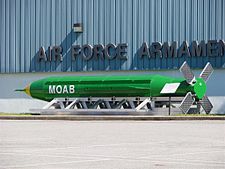 The heaviest non-nuclear bomb in the U.S. arsenal, specifically designed as a “bunker-buster,” has been ungraded according to the Pentagon. Recent improvements to the 30,000 pound Massive Ordnance Penetrator allow the bomb to penetrate an astonishing 200 feet underground before exploding. The hardened steel casing on the bomb weighs about 25,000 pounds which allows deep ground penetration. The bomb contains 5,300 pounds of high explosives.
The heaviest non-nuclear bomb in the U.S. arsenal, specifically designed as a “bunker-buster,” has been ungraded according to the Pentagon. Recent improvements to the 30,000 pound Massive Ordnance Penetrator allow the bomb to penetrate an astonishing 200 feet underground before exploding. The hardened steel casing on the bomb weighs about 25,000 pounds which allows deep ground penetration. The bomb contains 5,300 pounds of high explosives.
As implied by the Pentagon, the obvious first use of such a weapon would be to destroy underground nuclear bomb facilities in Iran, as reported by Bloomberg.
Tests of the 30,000-pound (13,600-kilogram) Massive Ordnance Penetrator made by Boeing Co. (BA) demonstrated the redesigned weapon “is capable of effectively prosecuting selected hardened, deeply buried targets,” Michael Gilmore, the Pentagon’s director of operational testing, said in a report to Congress.
Pentagon officials have said the bomb could be used if the U.S. decides to attack Iran’s nuclear program, with its deeply buried and hardened Fordo uranium enrichment facility that holds a stockpile of enriched uranium.
The testing assessment is the first public discussion of the bomb’s capabilities since early last year, when the Pentagon disclosed a need to improve it.
U.S. Air Force Lieutenant General Herbert Carlisle cited the 30,000-pound bomb at an industry conference in March as among U.S. capabilities in a potential attack on Iran.
The bomb made by Chicago-based Boeing has “great capability and we are continuing to make it better,” he said. “It is part of our arsenal if it is needed in that kind of scenario.”
Pentagon Comptroller Robert Hale said in a Jan. 20, 2012, request to Congress that the money was needed to “fix issues identified in testing, including tail-fin modifications and integrating a second fuse, enhance weapon capabilities, build test targets and conduct live weapon testing. The request funds the immediate requirement to support the desired upgrade schedule.”
America’s defense contractors have no peers in developing the world’s most destructive non-nuclear bombs. In addition to the heaviest bunker-buster bomb, the U.S. also has in its inventory the GBU43/B Massive Ordnance Air Blast Bomb, which is the most powerful non-nuclear bomb ever developed. Commonly known as the Mother of all Bombs (MOAB), it is packed with 18,700 pounds of high explosives, enough to level around 10 city blocks.
The basic operational concept bears some similarity to the BLU-82 Daisy Cutter, which was used to clear heavily wooded areas in the Vietnam War and in Iraq to clear mines and later as a psychological weapon against the Iraqi military. After witnessing the psychological impact of the BLU-82 on enemy soldiers, and not having any BLU-82 weapons remaining, the MOAB was developed partly to continue the role of intimidating the Iraqi soldiers. Pentagon officials had suggested their intention to use MOAB as an anti-personnel weapon, as part of the “shock and awe” strategy integral to the 2003 invasion of Iraq.
The MOAB is not a penetrator weapon and is primarily intended for soft to medium surface targets covering extended areas and targets in a contained environment such as a deep canyon or within a cave system. However, multiple strikes with lower yield ordnance may be more effective and can be delivered by fighter/bombers such as the F-16 with greater stand-off capability than the C-130 and C-17. High altitude carpet-bombing with much smaller 500 to 2,000 pound bombs delivered via heavy bombers such as the B-52 or B-2 is also highly effective at covering large areas.
Use It or Lose It?
Should the U.S. spend billions of dollars designing, developing and manufacturing the largest inventory of bombs in the world to use against other nations? Now that I think about it, I doubt if the average American could name five major countries that the U.S. has not bombed in the past 200 years.
Speak Your Mind